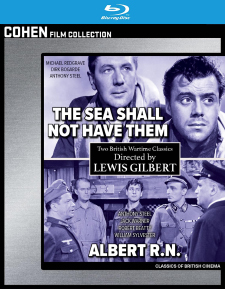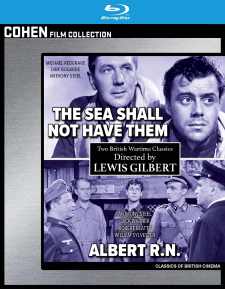Sea Shall Not Have Them, The/Albert R.N. (Blu-ray Review)

Director
Lewis GilbertRelease Date(s)
1954/1953 (January 23, 2024)Studio(s)
Angel Productions/Eros Films (Cohen Film Collection/Kino Lorber)- Film/Program Grade: B+
- Video Grade: B
- Audio Grade: B+
- Extras Grade: F
Review
British director Lewis Gilbert had a remarkable career, directing his first movie in 1945 and his last one in 2002, some 40 films over six decades. Among them: Carve Her Name with Pride (1958), Sink the Bismark! (1960), Alfie (1966), Educating Rita (1983), and three James Bond movies—You Only Live Twice (1967), The Spy Who Loved Me (1977), and Moonraker (1979). He died 11 days shy of his 98th birthday in 2018.
He directed movies of all kinds, but during the ’50s and ‘60s he specialized in war movies, often naval in nature. Two of Gilbert’s war movies not well-known outside of Britain make an interesting double-feature courtesy Cohen Media Group: The Sea Shall Not Have Them (1954) and Albert R.N. (1953). Both films are ensemble pieces featuring excellent casts of British stars and character actors, plus familiar Canadian and American expats with long careers in British films.
The Sea Shall Not Have Them, like most British World War II movies made during and immediately after the war, pays tribute to a particular branch of their armed forces, in this case the RAF’s Air Sea Rescue Service. The film is oddly structured, and nothing much happens until the last ten minutes or so, but most of what’s there is pretty interesting. During the fall of 1944, a British Lockheed Hudson ditches in the North Sea after combat with a German Messerschmitt. The four men aboard—Air Commodore Waltby (Michael Redgrave), Flight Sgt. MacKay (Dirk Bogarde), American Sgt. Kirby (Bonar Colleano), and the injured Flying Officer Harding (Jack Watling)—huddle in an inflatable raft, unsure whether their mayday alert was received, braving rough seas and bitterly cold winds. Waltby is couriering secret German plans kept in a briefcase, and it’s vital they reach England.
The Air Sea Rescue sends Launch 2561, commanded by Flying Officer Treherne (Anthony Steel) to search for survivors. (Somewhat confusingly at times, a sister Launch is also dispatched; it’s difficult at times to keep track of which sailors belong to which boat.) Further, a “Sea Otter” rescue plane crewed by Americans (Paul Carpenter and Eddie Byrne) pick up the downed Messerschmitt pilot (Anton Diffring) but become stranded themselves. Back in England, Group Capt. Todd (Griffith Jones), Squadron Leaders Scott (Guy Middleton) and Craig (Jack Lambert), along with Met Officer Howard (Nigel Green) map out strategies, while Kirby’s fiancée (Gudrun Ure), Waltby’s wife (Rachel Kempson, Redgrave’s real-life actress-wife), and the wife (Joan Sims) of one of the sailors (George Rose), anxiously await news of their loved ones.
While The Sea Shall Not Have Them boasts a terrific cast—besides those mentioned above, there’s also Nigel Patrick (very good), Victor Maddern, Michael Ripper, Michael Balfour, and others—the cutting between the two ships, the inflatable raft, the sea plane, and HQ results in a lot of dramatic clunkiness. Just as a character or situation at one setting starts getting interesting, the film cuts away to another location and other characters, or just the opposite happens—it lingers too long in one place when what’s happening elsewhere is more intriguing, and the audience gets impatient. There are some nice moments here and there, mostly little character vignettes, but as war movies go, it’s just slightly above average.
One problem with the film is the over-reliance on process shots, the kind of traveling mattes the British frequently used in the ’50s and ‘60s, even filmed television from ITC and others. Here, while it’s understandable mattes would be used for some of the at-sea footage, Gilbert cuts corners by using it at every opportunity: at train stations, on harbor docks, etc., giving the picture an air of cheapness.
Further, Cohen’s presentation of The Sea Shall Not Have Them is quite poor, the image so soft and washed out, coupled with some damage and wear, it resembles a below-average DVD rather than a high-def Blu-ray. One story has it that the picture was intended to part of a Dirk Bogarde retrospective until it was discovered that no theatrical prints survived. Coming from a minor producer and distributor it’s possible no good film elements exist but the video transfer is notably lacking and, on its own, rates a “D.”
Fortunately, Albert R.N., despite being from the same production company-distributor, is a fine transfer with no issues (rating an “A-“). In a German P.O.W. camp, “Mabel,” an escape tunnel, collapses and is discovered. In response, Lt. Ainsworth (Anthony Steel), a talented artist, proposes an ingeniously clever scheme: the creation of a lifelike mannequin named “Albert.” When the prisoners are escorted under heavy guard to a bathhouse beyond the wire, one of the men will remain there while “Albert” marches out under the arms of the rest of the prisoners, thus maintaining the original headcount.
Lt. Erickson (Paul Carpenter) is selected by the escape committee and Erickson’s flight appears successful. C.O. Capt. Maddox (top-billed Jack Warner) decides to wait a month before attempting to use Albert again. One of the prisoners, American Lt. Texas Norton (William Sylvester), determined not to wait, bribes sadistic SS Hauptsturmführer Schultz (Anton Diffring at his iciest) to turn off the boundary lights during the next air raid, but this ends tragically when Schultz double-crosses him. Meanwhile, Maddox, Lt. Reed (Robert Beatty) and others encourage Ainsworth to escape next—it was, after all, his idea—but he resists, believing his girl back home has forgotten him.
Albert R.N. plays better because it’s goals and characters are more focused than those in The Sea Shall Not Have Them, and because, despite the same ensemble-type casting (with much the same cast), the script limits its scope, focusing on about a half-dozen characters rather than several dozen. There are several effective vignettes scattered about; in one scene after lights out, as the men lie awake in their bunks, voice-overs allow the audience to hear their thoughts. One soldier (Guy Middleton), for instance, imagines he’s at a restaurant ordering a luxurious meal, a nightly ritual apparently. Jack Warner, not the Hollywood studio head, obviously, was a major star of the early ‘50s, and lends just the right fatherly leadership. Square-jawed Anthony Steel, another big star of British war movies who, like Warner, made no dent on the American market, has a better role here, clichéd though it is, in this film than in The Sea Shall Not Have Them.
Though probably shot for one-tenth the budget of John Sturges’s later The Great Escape (1963), the recreation of the prison camp, both exterior sets (built on Headley Heath) and interior soundstage ones, are very effective and realistic. Albert himself was based on a real creation by war artist John Worsley, who while held prisoner at Marlag O, a POW camp in Northern Germany, constructed such a head used in two escape attempts. Worsley himself recreated the head for Albert R.N.
As with The Sea Shall Not Have Them, part of the enjoyment is watching the cast at work, a mix of British stars and character actors, plus a good half-dozen expat American and Canadians with long careers in British films and television, as well as Hollywood-financed movies shot there. William Sylvester and Robert Beatty, for instance, both have substantial parts in Kubrick’s 2001: A Space Odyssey, while Eddie Byrne appeared in everything from Hammer horror films to Star Wars. Both pictures are scored by Malcolm Arnold, each sounding like a warm-up to Arnold’s music for The Bridge on the River Kwai, with some cues awfully close to those in David Lean’s epic.
Both films, presented on a single disc, are in black-and-white and in 1.37:1 standard format, which seems correct, even though the British film industry was gradually switching to widescreen at this time. As noted above, The Sea Shall Have Them looks pretty bad, soft and washed-out. Partly the overuse of process work is to blame, but the image really does resemble a mediocre DVD. Albert R.N., on the other hand, looks fine, the image is crisp and the blacks are black, not gray. Both are presented in DTS-HD Master Audio (2.0 mono), with optional English subtitles, and the disc is Region “A” encoded. What’s billed as a trailer for Albert R.N. is actually newly created, not an advertisement promoting the original release.
Neither film is a masterpiece but both are pretty good, Albert R.N. being the better of the two by not that wide a margin. The poor transfer of The Sea Shall Not Have Them is disappointing, but maybe only inferior film elements survive. In any case, overall this double-bill is recommended.
- Stuart Galbraith IV

